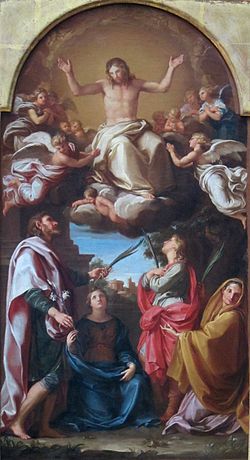Julian and Basilissa
- See also Saint Julian
| Saints Julian and Basilissa | |
|---|---|
 | |
| Died | ~304 AD |
| Honored in | Roman Catholic Church |
| Feast | January 9; January 6 |
| Attributes | palm of martyrdom |
| Patronage | Basilissa is invoked against chilblains |
Saints Julian and Basilissa (died ca. 304) were husband and wife. They were Christian martyrs who died at either Antioch or, more probably, at Antinoe, in the reign of Diocletian, early in the fourth century, on 9 January, according to the Roman Martyrology, or 8 January, according to the Greek Menaea.
Their feast day is also given as 6 January, while a group of people martyred with Julian (Celsus, Marcionilla, Anthony, Anastasius) have the feast day of January 9.
There exists no historically certain data relating to these two holy personages, and more than once this Julian of Antinoe has been confounded with Julian of Cilicia. The confusion is easily explained by the fact that thirty-nine saints of this name are mentioned in the Roman Martyrology, eight of whom are commemorated in the one month of January. But little is known of this saint, once we put aside the exaggerations of his Acts.
Legend
[edit]Forced by his family to marry, he agreed with his spouse, Basilissa, that they should both preserve their virginity, and further encouraged her to found a convent for women, of which she became the superior, while he himself gathered a large number of monks and undertook their direction. The two converted their home into a hospital which could house up to 1,000 people (thus, Julian is often confused with Julian the Hospitaller).
Basilissa died a very holy death, but martyrdom was reserved for Julian under the persecutions of Diocletian.
Celsus, the young son of Marcionilla, was martyred along with Julian. The priest Anthony (Antony) was martyred at the same time, as well as a convert and neophyte named Anastasius. Marcionilla's seven brothers are also said to have been killed.
Julian's Martyrdom
[edit]During the persecution of Diocletian he was arrested, tortured, and put to death at Antioch, in Syria, by the order of the governor, Martian, according to the Latins, at Antinoe, in Egypt, according to the Greeks, which seems more probable. Unfortunately, the Acts of this martyr belong to those pious romances so much appreciated in early times, whose authors, concerned only for the edification of their readers, drowned the few known facts in a mass of imaginary details. Like many similar lives of saints, it offers miracles, prodigies, and improbable utterances, that lack the least historical value.
Veneration
[edit]In any case, these two saints must have enjoyed a great reputation in antiquity, and their veneration was well established before the eighth century. In the Martyrologium Hieronymianum they are mentioned under 6 January; Usuard, Ado, Notker of St Gall, and others place them under the ninth, and Rabanus Maurus under the thirteenth of the same month, while Vandelbert puts them under 13 February, and the Menology of Canisius under 21 June, the day to which the Greek Menaea assign St. Julian of Caesarea. There used to exist at Constantinople a church under the invocation of these saints, the dedication of which is inscribed in the Greek Calendar under 5 July.
Only a fragment of Ælfric's Passion of St. Julian and His Wife Basilissa from his Lives of the Saints has survived, but the traditional legend is there: the two saints vow not to consummate their marriage on their wedding night, and devote themselves to clænnysse ("chastity"). Julian suffers martyrdom by beheading.[1]
External links
[edit]- [[Archivo:
- REDIRECCIÓN Plantilla:Iconos|20px|Ver el portal sobre Saints]] Portal:Saints. Contenido relacionado con Saints.
- Catholic Encyclopedia: Sts. Julian and Basilissa
- St. Basilissa
- St. Julian
- Kevin Kiernan, Odd Couples in Ælfric's Julian and Basilissa in British Library Cotton MS Otho B. x
- Julian, Basilissa, Antony, Anastasius and Companions
- "Saints Marcianilla, Celsus, and Basilissa" in Christian Iconography
![]() This article incorporates text from a publication now in the public domain: Herbermann, Charles, ed. (1913). Catholic Encyclopedia. Robert Appleton Company.
This article incorporates text from a publication now in the public domain: Herbermann, Charles, ed. (1913). Catholic Encyclopedia. Robert Appleton Company. {{cite encyclopedia}}: Cite has empty unknown parameters: |1=, |month=, and |coauthors= (help); Invalid |ref=harv (help); Missing or empty |title= (help)
pt:Julião e Basilissa
tr:Jülyen
- Pages using the JsonConfig extension
- CS1 errors: empty unknown parameters
- CS1 errors: missing title
- CS1 errors: invalid parameter value
- Articles incorporating text from the 1913 Catholic Encyclopedia without Wikisource reference
- Articles incorporating text from the 1913 Catholic Encyclopedia with no article parameter
- Married couples
- Articles about multiple people
- 304 deaths
- 4th-century Christian martyr saints
- 4th-century Romans
- 4th-century Christian female saints
